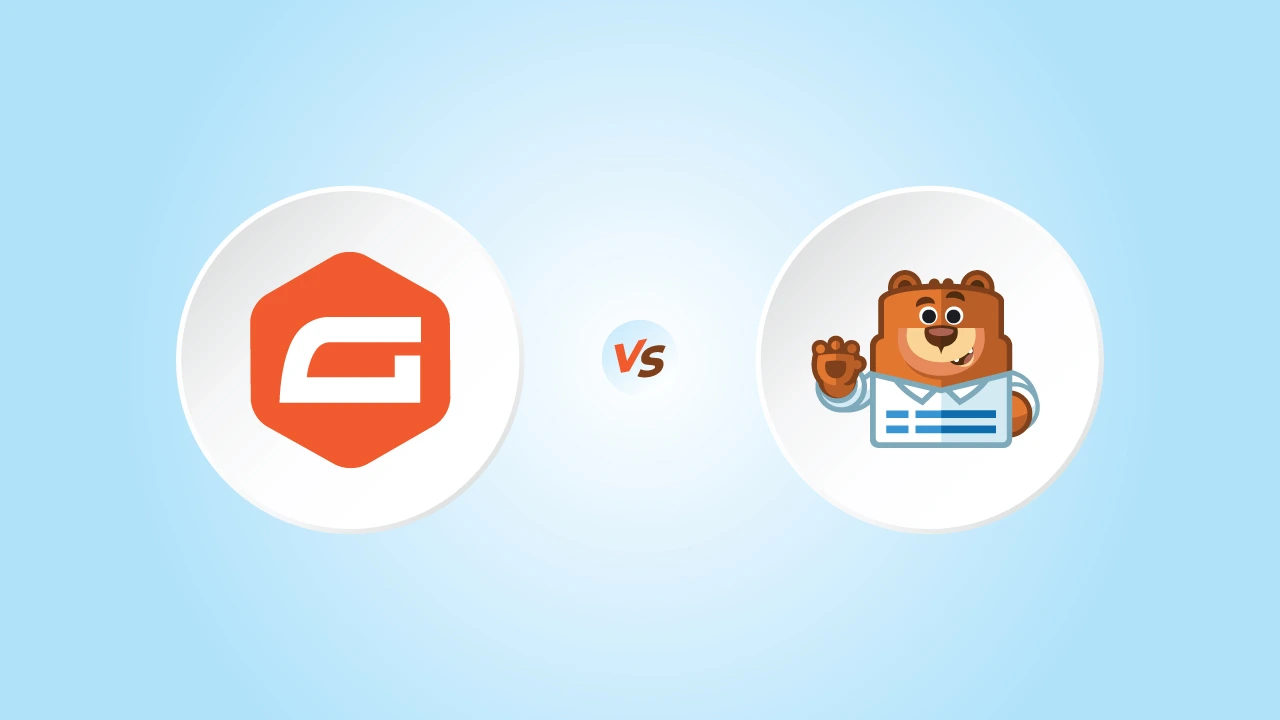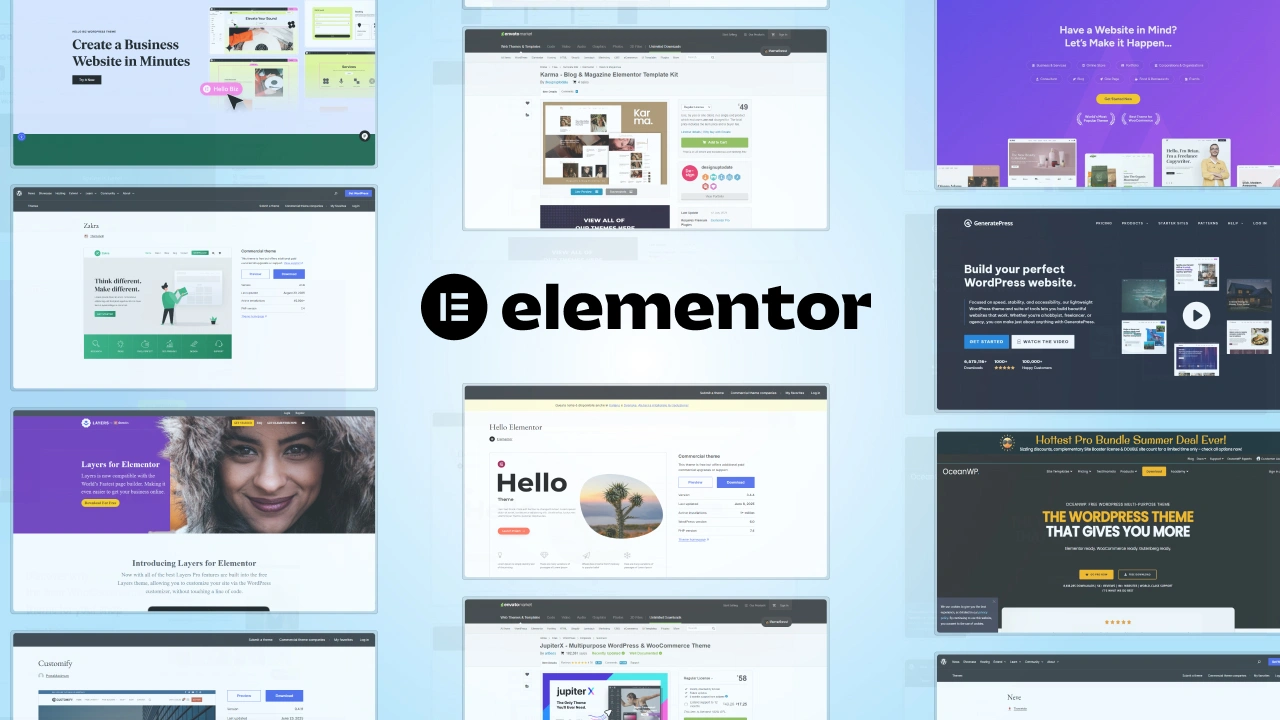You are wrong if you think WordPress form plugins are just about collecting emails. In 2025, they handle everything from payments and lead scoring to multi-step onboarding flows and AI-driven responses.
If you are deciding between Gravity Forms and WPForms, this isn’t a choice between two similar tools — it’s a decision that can affect your site speed, conversion rate, and backend workflow for years.
The problem?
Well, most comparisons just list features side-by-side without helping you understand what actually matters in real-world scenarios — like what happens when you scale to 100+ forms, how fast a form loads on mobile, or what switching costs look like six months in.
This guide skips the fluff.
We are breaking down Gravity Forms vs. WPForms based on how they perform today, under pressure — not just on paper. You will see performance benchmarks, conversion-focused features, pricing based on use case, and where each plugin actually fits best.
By the end, you won’t just know what they offer — you will know which one fits your specific stack, team, and goals.
⏰ 60-Second Summary
- WPForms is the go-to choice for beginners, marketers, and anyone who wants to create clean, high-converting online forms quickly — especially with its free version and rich pre-built templates.
- Gravity Forms is built for power users, developers, and agencies who need advanced features like conditional logic, complex workflows, and better scalability across large sites or client projects.
- Performance-wise, WPForms is faster and lighter for simple forms, while Gravity Forms can handle more complexity but may require optimization.
- When it comes to pricing, WPForms is more budget-friendly upfront, but Gravity Forms offers better value long-term for teams managing multiple sites or needing full control.
- Switching between the two isn’t simple — there’s no easy migration, so it’s important to pick based on where your site is headed, not just where it is today.
- Bottom line: Choose WPForms for speed and simplicity. Go with Gravity Forms if you need flexibility and plan to scale or create complex forms down the line.
Speed & Performance: How Fast Do These Plugins Really Load?
Nobody likes a slow site. Especially in 2025, where users bounce if a page takes more than a couple of seconds to load. So when you are choosing a form plugin, performance should be high on your list — not just for user experience, but also for SEO.
Let’s talk about how Gravity Forms and WPForms hold up when it comes to speed.
WPForms: Built for Speed from the Start
WPForms is lightweight by design. It loads only the scripts and styles needed for each form — which means it doesn’t drag your site down with extra code. For most basic forms (like contact or newsletter signups), WPForms keeps things fast and smooth, even on slower hosting.
In testing, a simple contact form using WPForms added very little to the page load time — just a few kilobytes of CSS and JavaScript. On mobile, it still felt snappy and responsive, even on slower networks.
Gravity Forms: Heavier, but More Powerful
Gravity Forms is more powerful under the hood — and with that comes a bit more weight. It’s designed to handle more complex logic, conditional fields, calculations, and advanced workflows. But the trade-off is that it tends to load more assets, even for basic forms.
A standard Gravity Forms contact form loads slightly more code than WPForms. Is it a dealbreaker? Not necessarily. But if your site is already pushing its performance limits, or you are obsessive about load time, it’s something to keep in mind.
Mobile Experience Matters Too
Both plugins are mobile-friendly, but WPForms wins here in terms of smooth interaction. Fields are well spaced, and the form adjusts nicely across screen sizes without much tweaking.
Gravity Forms works fine on mobile, but in some cases, especially with complex forms, you might need a little extra CSS to make everything feel just right.
The Bottom Line:
- WPForms is better if you care about speed and want something lightweight that “just works” out of the box.
- Gravity Forms can still be fast, but you may need to optimize a bit more — especially if your forms are doing a lot of heavy lifting.
From strategy to launch, cmsMinds specializes in scalable WordPress solutions — including form integrations, automations, and advanced workflows.
Features That Actually Help You Convert Visitors
Let’s be honest — most people don’t care how many features a plugin has. What really matters is: Does this help me get more leads, more signups, or more sales?
So instead of listing every little option, let’s focus on the features in Gravity Forms and WPForms that can actually help you convert better.
Multi-Step Forms: Guide Your Users
Sometimes, long forms scare people away. That’s where multi-step forms come in. You break the form into chunks, and users go through it one step at a time — kind of like a mini-survey.
- WPForms makes this really easy. It’s drag-and-drop, looks clean, and even comes with a progress bar.
- Gravity Forms does this too, but it takes a little more effort to style it nicely. It’s flexible, but not as plug-and-play.
If you want something simple and fast, WPForms is the better pick. If you are okay tweaking the design a bit, Gravity Forms can still get the job done.
Conditional Logic: Show What Matters
Both plugins let you show or hide fields based on what someone chooses — like if they select “Business” from a dropdown, a different set of questions appears.
- Gravity Forms gives you more control here. You can create really advanced logic flows, even across multiple pages.
- WPForms covers the basics well, but if your form gets too complex, you might hit a wall.
So, if you are building a straightforward form — say, a simple quote request — WPForms is perfect. But if you are doing something complex, like custom onboarding or dynamic pricing, Gravity Forms is stronger.
Conversational Forms: Chat-Like Experience
This one’s cool. Conversational forms feel more like a chat — one question at a time, instead of a full form on a page. It can make filling out forms feel a lot more personal.
- WPForms has this built-in. Super easy to set up. Great for lead gen.
- Gravity Forms doesn’t have it out of the box — you’ll need an add-on or custom work.
If engagement is your main goal, WPForms wins this round.
Spam Protection
Nobody wants spam clogging up their inbox.
- Both support Google reCAPTCHA and hCaptcha
- WPForms also has a built-in anti-spam feature that works quietly in the background
- Gravity Forms gives you more control if you want to use third-party spam blockers or write custom rules
Both are solid — WPForms is simpler, Gravity Forms is more flexible.
The Bottom Line:
- If you want fast, polished, conversion-ready forms with minimal setup: WPForms nails it.
- If you want control, complexity, and don’t mind getting hands-on: Gravity Forms gives you more power.
Which Plugin Works Best for Your Use Case?
Let’s skip the theoretical stuff and talk about real situations. Because what works for a solo blogger might be a headache for a web development agency managing 20 client sites. Here’s how Gravity Forms and WPForms stack up, depending on what you are actually trying to build.
Use Case 1. A Personal Blog or Simple Business Site
You want a clean contact form, maybe a newsletter signup, and something for occasional inquiries. You don’t want to mess with settings for hours, and you definitely don’t want to pay for things you’ll never use.
Best pick: WPForms
- It’s beginner-friendly
- Easy to set up and forget
- The free version (WPForms Lite) may even be enough if you don’t need payments or logic
Use Case 2. An Agency or Freelancer Building for Clients
You need flexibility. Different clients, different needs. One wants conditional logic, another needs Stripe payments, another wants forms that feed into their CRM. You also want reliability — you don’t want your client calling because a form broke.
Best pick: Gravity Forms
- Tons of integrations and control
- Easier to create reusable form templates across projects
- Better for handling weird, custom form needs (multi-page + logic + calculations)
Use Case 3. An eCommerce Store (WooCommerce or Similar)
You are collecting user info, processing payments, running giveaways, and maybe using forms for product inquiries or custom orders.
Best pick: Tie — but for different reasons
- WPForms: Easier for quick payment forms (Stripe, PayPal), smoother UX
- Gravity Forms: More flexibility for advanced logic, custom pricing calculators, or upsell workflows
If it’s simple: WPForms. If it’s custom or complex: Gravity Forms.
Use Case 4. Large Sites with Complex Workflows
You’ve got a membership site, internal applications, or need to automate processes like approvals or conditional email routing.
Best pick: Gravity Forms
- Handles complex conditional workflows like a pro
- More control over data processing, user roles, and backend logic
- You can basically build full apps with the right add-ons
Use Case 5. Lead Gen or Marketing-Focused Site
You are focused on conversion. You want sleek, engaging forms — maybe even chat-style — and easy connections to tools like Mailchimp, HubSpot, or Salesforce.
Best pick: WPForms
- Conversational forms built-in
- Integrates well with most CRMs and marketing tools
- Designed with marketers in mind — minimal fuss, fast results
The Bottom Line:
There’s no one-size-fits-all.
- WPForms wins for simplicity, speed, and marketers.
- Gravity Forms wins for flexibility, advanced workflows, and developers.
Pricing: What Are You Really Paying For?
Let’s face it — pricing pages are designed to confuse you. You see a bunch of tiers, long feature lists, and vague “pro” labels, but no real clarity on what you actually need.
So instead of just showing prices, here’s what you get (and don’t get) with Gravity Forms and WPForms, based on how you are planning to use them.
For Solo Site Owners or Bloggers
You are probably just looking for a basic form builder — contact forms, maybe a simple email signup or feedback form.
WPForms Lite (free) is more than enough to get started. It includes:
- A drag-and-drop builder
- A few solid pre-built form templates
- Basic spam protection
- Entry management in the paid version only
Gravity Forms doesn’t have a free version. You’ll need to go straight to a paid plan ($59+/year), which makes it a tougher sell unless you know you’ll need the advanced features.
💡 Winner for solo sites: WPForms — you can do a lot without spending a dime.
For Freelancers or Agencies
Here’s where things get tricky. You need more power — like advanced fields, conditional logic, and integration with tools like Stripe, Mailchimp, or Zapier. And you are probably managing more than one site.
- WPForms Pro ($199.50/year): Includes full access to form templates, payments, marketing integrations, and priority support.
| Basic | Plus | Pro (Best Deal) | Elite |
|---|---|---|---|
| $49.50/Year | $99.50/Year | $199.50/Year | $299.50/Year |
|
Everything in Basic, and:
|
Everything in Plus, and:
|
Everything in Pro, and:
|
- Gravity Forms Elite ($259/year): Gives you unlimited site usage, developer tools, advanced add-ons, and the ability to build custom form-based workflows.
| Basic License | Pro License | Elite License (Best Value) |
|---|---|---|
| $99/Year | $159/Year | $259/Year |
|
|
|
If you are building multiple sites and want a future-proof form builder with no site limits, Gravity Forms is usually the better value — even if it costs a bit more.
For Businesses or Larger Teams
If your forms are doing more than collecting emails — think custom quoting, onboarding forms, user-submitted content, or handling hundreds of submissions per month — you’ll want reliability, automation, and clean workflows.
Gravity Forms has a better high-end offering:
- More complex logic and field control
- Easier to extend with developer hooks
- Better for automation-heavy setups
WPForms can still work well, especially if you prefer simplicity and speed, but it can hit limits in more advanced use cases.
What About Form Templates?
Both plugins offer a library of pre-built form templates — things like contact forms, donation forms, job applications, surveys, etc.
- WPForms offers a huge selection out of the box. It’s great if you want to launch fast without building from scratch.
- Gravity Forms has fewer templates by default, but with its flexibility, you can create your own templates and save them across projects — a big plus for agencies.
The Bottom Line:
- WPForms wins on price for beginners and small sites, especially with its free version and rich set of form templates.
- Gravity Forms makes more sense for developers, agencies, or anyone who wants a serious form builder with full control and unlimited site usage.
Scalability & Maintenance: What Happens as Your Site Grows?
It’s easy to love a WordPress form plugin when your site is small and your needs are simple. An easy contact form here, a quick survey there — no big deal.
But what happens when you go from 5 forms to 50? Or from a few submissions a week to hundreds per day? That’s where the cracks start to show in some plugins — and why it’s smart to think about scalability upfront.
How Well Do They Handle Bigger Workloads?
Let’s say you are running a site with dozens of forms — maybe for job applications, service quotes, or internal team requests. Or maybe you are managing client sites, each with their own set of custom forms. You don’t want to be digging through cluttered interfaces or running into limits.
Gravity Forms handles large setups better.
- It gives you more control over organizing, exporting, and managing large numbers of forms.
- You can filter, tag, and manage entries easily — even when you are working with hundreds of them.
- It’s built to handle complex forms and payment forms without choking under pressure.
WPForms, while very user-friendly, can feel a bit tight once you start working with a lot of forms or entries.
- The dashboard is clean, but bulk actions and advanced management tools are limited.
- If you are working with 5–10 forms, no problem. If you are managing dozens across clients, it can start to feel like a chore.
Maintenance & Plugin Updates
Both plugins are actively developed and supported, but their approach is different.
WPForms is built for simplicity. Updates are usually smooth, and you rarely have to think about compatibility issues — especially if you are using it for basic tasks like a simple contact form or newsletter signup.
Gravity Forms gives more freedom but also puts more responsibility on you.
- If you are using advanced add-ons, or you’ve customized logic, you’ll want to test updates before going live.
- That said, it’s incredibly stable — especially when handling forms that connect to third-party services or pull off complicated logic.
Entry Storage & Exporting Data
At some point, you’ll want to dig into your form data — whether it’s exporting leads, analyzing submissions, or migrating to another tool.
- Gravity Forms makes exporting easy and flexible, especially when you want to filter by fields, dates, or user input.
- WPForms lets you export too, but with fewer customization options unless you are on a higher-tier plan.
The Bottom Line:
- If you are keeping it light — a few forms, basic needs — WPForms is easy to maintain and perfect for everyday use.
- If you are building out a serious form system — lots of users, payment forms, advanced workflows — Gravity Forms is better built for the long haul.
Migration & Switching Costs: What Happens If You Change Your Mind?
It’s easy to pick a form plugin and stick with it — until your needs grow, or you run into limitations, or your team starts asking for features that weren’t on your radar before. That’s when switching becomes a real consideration.
So let’s talk about what it’s like to move between WPForms vs Gravity Forms, and what you should know before choosing either as your best WordPress form plugin.
Can You Migrate from One to the Other?
Here’s the truth: there’s no one-click migration tool between WPForms and Gravity Forms. If you decide to switch later, you are basically rebuilding your online forms from scratch — especially if you’ve used custom logic, conditional fields, or payment integrations.
From WPForms to Gravity Forms:
- You’ll need to manually recreate your forms
- No automated import for entries or templates
- If you were using pre-built templates in WPForms, you’ll likely need to recreate layouts in Gravity
From Gravity Forms to WPForms:
- Same deal — no direct importer
- You may run into limits if your forms were complex or used niche add-ons
In short, whichever plugin you choose, stick with it if you can — switching takes time, and potentially money.
How Much Work Is Rebuilding?
It depends on the kind of forms you are using:
- A few simple contact forms or lead gen forms? Not a big deal. You’ll probably rebuild those in under an hour.
- But if you need to create complex forms — with conditional logic, multi-page flows, or payment integration — it’s a much heavier lift.
This is where Gravity Forms shows its age (in a good way): it’s been around longer, and more devs are familiar with customizing it. That can make rebuilding less painful if you are moving into it.
What About Paid Plans?
Here’s something a lot of folks miss:
- WPForms charges annually, and if you stop paying, some key features stop working (like entry management or marketing integrations).
- Gravity Forms also has annual pricing, but your forms don’t break if your license expires — you just lose updates and support.
So if budget is tight or long-term cost matters, that’s something to weigh when deciding on the best WordPress form plugin for your needs.
When You Are Starting Fresh
If you haven’t chosen a plugin yet, here’s the play:
- If you are building a few basic online forms — think contact forms, surveys, or event RSVPs — WPForms is a quick, clean choice.
- If you are planning on creating online forms that go deep — quotes, applications, workflows — and you want full control, Gravity Forms is the safer long-term bet.
The Bottom Line:
- Switching between WPForms vs Gravity Forms isn’t easy — so choose wisely up front.
- Think about where your site will be 6 or 12 months from now, not just what you need today.
- If you are likely to create complex forms down the line, lean toward flexibility from the start.
Final Verdict: Which Form Plugin Should You Choose?
By now, you have seen that there’s no one-size-fits-all answer in the WPForms vs Gravity Forms debate. Both are great tools — but they solve different problems for different types of users.
So let’s keep this simple. Here’s a quick breakdown of who should choose what and why.
Quick Comparison Table
| Feature | WPForms | Gravity Forms |
|---|---|---|
| Ease of Use | Super beginner-friendly | Slight learning curve |
| Free Version Available | Yes (WPForms Lite) | No free version |
| Pre-built Form Templates | Lots of ready-to-use forms | Fewer, more custom-based |
| Creating Complex Forms | Limited flexibility | Designed for complex forms |
| Payment Forms | Easy setup with add-ons | More control + logic options |
| Developer Control & Custom Hooks | Limited | Developer-friendly |
| Long-Term Scalability | Better for small/medium sites | Built for scale |
| Support & Documentation | Strong for beginners | Strong for devs/advanced users |
Final Recommendations
Choose WPForms if:
- You are building basic to moderately advanced online forms
- You want to move fast with pre-built form templates
- You are focused on conversions, clean UX, and don’t want to mess with code
- You are working on a smaller site, blog, or running simple payment forms
Choose Gravity Forms if:
- You need full control and plan to create complex forms
- You are building workflows, advanced logic, or multi-step applications
- You are managing client sites or large projects where scale matters
- You are comfortable getting a little technical when needed
Still Not Sure?
If you are on the fence, start small:
- Try WPForms Lite (it’s free) and build a straightforward contact form or lead capture form.
- If you quickly hit limitations — or you are already thinking about automation, conditional logic, or multiple integrations — Gravity Forms is likely the better investment.
Let our WordPress experts at cmsMinds help you pick, set up, and customize the right solution for your business.





